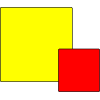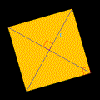Skip over navigation
You could cut up some straws to the equivalent lengths and try this for real.
Alternatively, how about drawing some nets and cutting them out to test them?


Or search by topic
Number and algebra
Geometry and measure
Probability and statistics
Working mathematically
Advanced mathematics
For younger learners
Tet-trouble
Age 14 to 16
Challenge Level 





- Problem
- Getting Started
- Student Solutions
- Teachers' Resources
You could cut up some straws to the equivalent lengths and try this for real.
Alternatively, how about drawing some nets and cutting them out to test them?
You may also like
Two Cubes
Two cubes, each with integral side lengths, have a combined volume equal to the total of the lengths of their edges. How big are the cubes? [If you find a result by 'trial and error' you'll need to prove you have found all possible solutions.]
Square Mean
Is the mean of the squares of two numbers greater than, or less than, the square of their means?

